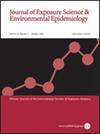高交通噪音暴露和社会经济剥夺对压力相关神经活动、动脉粥样硬化炎症和心血管疾病事件的叠加效应。
IF 4.7
3区 医学
Q2 ENVIRONMENTAL SCIENCES
Journal of Exposure Science and Environmental Epidemiology
Pub Date : 2024-11-22
DOI:10.1038/s41370-024-00734-2
引用次数: 0
摘要
背景:噪声暴露和较低的社会经济地位(SES)都与心血管疾病(CVD)风险的增加有独立联系。尽管这些因素经常同时存在,但人们对它们的综合影响和潜在的病理生理机制仍然知之甚少:本研究旨在评估高交通噪声暴露和较低社会经济地位对主要不良心血管事件(MACE)的共同影响,以及神经-动脉轴在调解这种关系中的作用:我们回顾性分析了在一个中心接受临床 18F-FDG-PET/CT 成像检查的 507 人的数据。我们使用当地收入中位数(作为主要测量指标)和地区贫困指数(ADI,作为次要测量指标)对 SES 进行了评估。根据交通噪声暴露和收入/ADI,将参与者分为三组:低噪声/较高社会经济地位组、高噪声或较低社会经济地位组、高噪声/较低社会经济地位组。Cox 模型评估了 MACE 风险。线性回归模型评估了与压力相关的神经活动(SNA)和动脉炎症(ArtI)之间的关系:结果:高噪音暴露和低收入(与两者均不暴露相比)的组合与 MACE 风险增加有关(HR [95% CI]:5.597[2.201-14.233],P 影响声明:我们的研究独特地展示了高交通噪声和较低的社会经济地位如何通过特定的生物途径,尤其是通过对压力相关神经活动和动脉炎症的影响,叠加地增加心血管疾病的风险。因此,这项研究为了解环境和社会经济因素在心血管健康中的相互作用提供了新的视角。这突出表明,迫切需要采取综合的公共卫生战略来解决噪声污染和社会经济差异问题,并为采取有针对性的干预措施以减轻弱势群体的心血管疾病负担奠定基础。连接交通噪声/社会经济状况暴露群体与 MACE 的假设机理途径的中心图示。SNA 压力相关神经活动(AmygAc-杏仁核与背景皮层活动的比率)、MACE 主要不良心血管事件、ArtI 动脉炎症、ADI 地区剥夺指数、SES 社会经济地位。本文章由计算机程序翻译,如有差异,请以英文原文为准。

Additive effect of high transportation noise exposure and socioeconomic deprivation on stress-associated neural activity, atherosclerotic inflammation, and cardiovascular disease events
Noise exposure and lower socioeconomic status (SES) are both independently linked to increased cardiovascular disease (CVD) risk. Although these factors frequently coexist, their combined impact and the underlying pathophysiological mechanisms remain poorly understood. This study aimed to evaluate the joint effects of high transportation noise exposure and lower SES on major adverse cardiovascular events (MACE) and the role of the neural-arterial axis in mediating this relationship. We retrospectively analyzed data from 507 individuals who underwent clinical 18F-FDG-PET/CT imaging at a single center. SES was evaluated using local median income (as a primary measure) and area deprivation index (ADI, as a secondary measure). Participants were classified into three groups based on transportation noise exposure and income/ADI: low noise/higher SES, high noise or lower SES, and high noise/lower SES. Cox models assessed MACE risks. Linear regression models evaluated associations with stress-related neural activity (SNA) and arterial inflammation (ArtI). The combination of high noise exposure and low income (vs. neither exposure) associated with increased MACE risk (HR [95% CI]: 5.597 [2.201–14.233], p < 0.001). SNA (standardized β [95% CI]: 0.389 [0.192–0.586], p < 0.001) and ArtI (0.151 [0.005–0.298], p = 0.043) were greater in this group. Mediation analysis showed that the neural-arterial axis contributes to increased exposure-related MACE risk and accounts for 8% of the overall effect. Similar results were found with ADI. Our study uniquely demonstrates how combined high transportation noise and lower socioeconomic status additively increases cardiovascular disease risk through specific biological pathways, particularly via effects on stress-associated neural activity and arterial inflammation. As such, the research offers novel insights into the interplay between environmental and socioeconomic factors in cardiovascular health. This underscores an urgent need for integrated public health strategies that address both noise pollution and socioeconomic disparities and provides a foundation for targeted interventions aimed at reducing the burden of cardiovascular disease in vulnerable populations.
求助全文
通过发布文献求助,成功后即可免费获取论文全文。
去求助
来源期刊
CiteScore
8.90
自引率
6.70%
发文量
93
审稿时长
3 months
期刊介绍:
Journal of Exposure Science and Environmental Epidemiology (JESEE) aims to be the premier and authoritative source of information on advances in exposure science for professionals in a wide range of environmental and public health disciplines.
JESEE publishes original peer-reviewed research presenting significant advances in exposure science and exposure analysis, including development and application of the latest technologies for measuring exposures, and innovative computational approaches for translating novel data streams to characterize and predict exposures. The types of papers published in the research section of JESEE are original research articles, translation studies, and correspondence. Reported results should further understanding of the relationship between environmental exposure and human health, describe evaluated novel exposure science tools, or demonstrate potential of exposure science to enable decisions and actions that promote and protect human health.

 求助内容:
求助内容: 应助结果提醒方式:
应助结果提醒方式:


